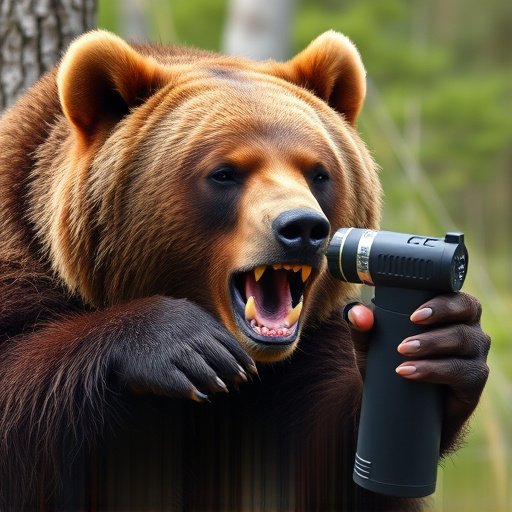Bear spray is a mandatory safety measure in North American national parks, with varying regulations regarding type, storage, and usage. To ensure effectiveness during bear encounters, users must understand local Bear Spray Laws, choose the right spray with potent ingredients, learn proper application techniques (aiming for the face and eyes from 20-30 feet), and regularly maintain their equipment. In addition to carrying bear spray, visitors should practice food storage safety, remain calm during encounters, and avoid surprises by maintaining a safe distance from bears.
Staying safe while exploring nature is paramount, especially when sharing spaces with aggressive bears. This comprehensive guide explores effective outdoor protection strategies against these formidable creatures, focusing on bear spray as a primary defense. We delve into the science behind its effectiveness and provide insights on crucial aspects like understanding local Bear Spray Laws in National Parks and choosing the right product for your needs. Additionally, we offer valuable tips for navigating aggressive bear encounters beyond just spray.
- Understanding Bear Spray: Effectiveness and Usage
- Bear Spray Laws in National Parks: What You Need to Know
- Choosing the Right Bear Spray for Your Needs
- Additional Measures for Aggressive Bear Encounters
Understanding Bear Spray: Effectiveness and Usage
Bear spray, also known as bear repellent, is a crucial tool for outdoor enthusiasts navigating areas with aggressive bears. Its effectiveness lies in its ability to create a barrier between the user and the bear by emitting a potent stream of irritants when sprayed. These irritants can temporarily blind and disorient the bear, allowing the person to escape or defend themselves.
When using bear spray in National Parks, it’s essential to follow local regulations and guidelines. Bear spray laws vary across different parks, so understanding the specific rules is vital. Users should familiarize themselves with proper usage techniques, such as spraying directly towards the bear’s face and eyes, ensuring a safe distance of 20-30 feet. Regular maintenance and checking of expiration dates are also necessary to ensure the spray remains effective during outdoor adventures.
Bear Spray Laws in National Parks: What You Need to Know
In many national parks across North America, carrying bear spray is not just recommended but mandated by law. Bear spray laws in national parks vary from region to region, but their primary goal is to ensure the safety of both visitors and bears. Understanding these regulations is crucial for anyone planning a trip into bear country. National park services enforce strict rules regarding the type, quantity, and storage of bear spray, as well as how it can be used.
Visitors are typically required to carry bear spray that meets specific criteria for strength and effectiveness. Using bear spray in national parks should only be considered as a last resort when faced with an aggressive or defensive bear encounter. Proper training on how to use bear spray is essential to ensure its effectiveness during an emergency situation. By adhering to the Bear Spray Laws in National Parks, visitors can enjoy their outdoor adventures while minimizing potential risks from wild bears.
Choosing the Right Bear Spray for Your Needs
When venturing into areas known for bear populations, selecting the appropriate bear spray is vital for your safety. Not all bear sprays are created equal, and understanding the factors that influence their effectiveness is key. Consider factors like can size, spray pattern, and concentration of capsaicin, the active ingredient. Check local Bear Spray Laws in national parks and outdoor recreation areas, as regulations vary by region.
Additionally, familiarize yourself with the distance and duration of protection offered by different brands. Some bear sprays have a broader reach, while others are designed for closer encounters. Always inspect the spray before heading out and ensure it’s well-maintained and within its expiration date. Proper usage involves aiming for the bears’ faces and eyes, as this is where capsaicin takes effect most quickly.
Additional Measures for Aggressive Bear Encounters
In the event of an aggressive bear encounter, beyond carrying bear spray (which is mandated in many National Park areas), several additional measures can significantly enhance your safety. Knowing how to respond during such encounters is crucial. Stay calm and assess the bear’s behavior; if it displays defensive or aggressive posturing, make yourself appear larger by raising your arms above your head without making direct eye contact. Make loud noises to deter the bear, but avoid sudden movements that might be perceived as a threat.
Bear-resistant food storage containers are essential when camping in areas known for bear activity. Food should always be securely stored outside your accommodation and away from your sleeping area. Some National Parks have specific guidelines regarding food storage, so it’s vital to check local regulations. Additionally, keeping a safe distance from bears and avoiding surprising them is paramount. Bears can be unpredictable, so remaining alert and being prepared for an encounter could save you from a potentially dangerous situation.
When venturing into areas with aggressive bear populations, understanding and adhering to local regulations, especially regarding bear spray laws in national parks, is paramount. By choosing the right bear spray and knowing how and when to use it, you can significantly enhance your safety during outdoor activities. Remember, while these measures provide protection, they should complement other precautions to ensure a safe and enjoyable experience in nature’s realm.
